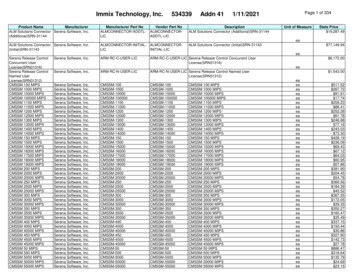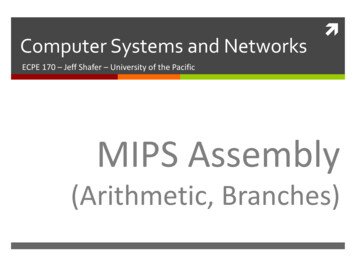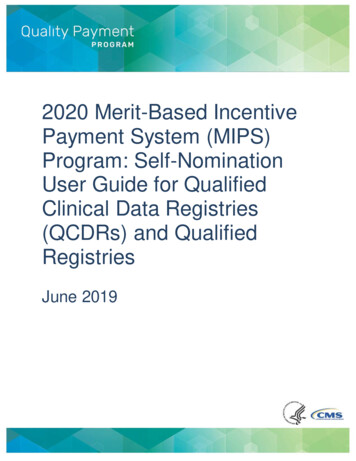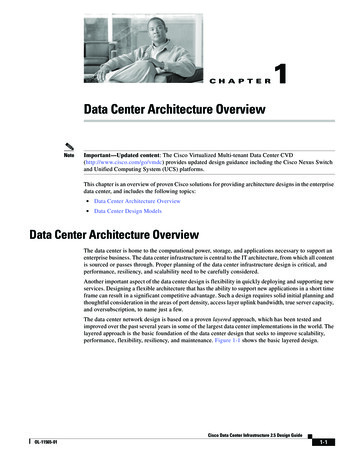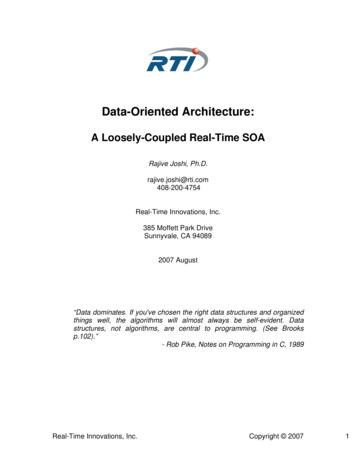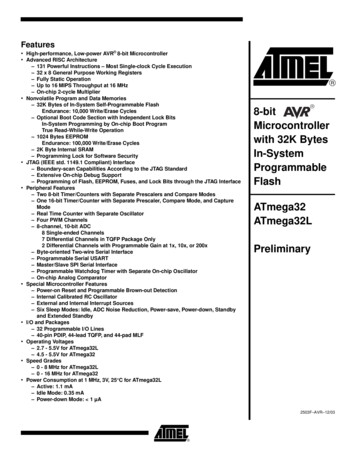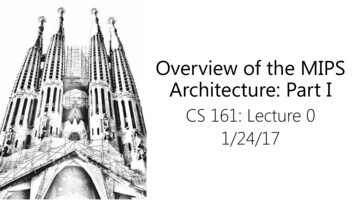
Transcription
Overview of the MIPSArchitecture: Part ICS 161: Lecture 01/24/17
Looking Behind theCurtain of Software The OS sits between hardware and user-levelsoftware, providing: Isolation (e.g., to give each process a separatememory region) Fairness (e.g., via CPU scheduling) Higher-level abstractions for low-level resourceslike IO devices To really understand how software works, youhave to understand how the hardware works! Despite OS abstractions, low-level hardwarebehavior is often still visible to user-levelapplications Ex: Disk thrashing
Processors: From the View of a Terrible ProgrammerLetter “m” Drawingof birdSource codeANSWERSCompilationadd t0, t1, t2lw t3, 16(t0)slt t0, t1, 0x6eb21Machine instructionsA HARDWARE MAGIC OCCURS
Processors: From the View of a MediocreProgrammerRegistersPCALUInstructionto executeRAM Program instructions livein RAM PC register points to thememory address of theinstruction to fetch andexecute next Arithmetic logic unit (ALU)performs operations onregisters, writes newvalues to registers ormemory, generatesoutputs which determinewhether to branchesshould be taken Some instructions causedevices to perform actionsDevices
Processors: From the View of a MediocreProgrammer Registers versus RAMRegistersPCALU Registers are orders ofmagnitude faster forALU to access (0.3nsversus 120ns) RAM is orders ofmagnitude larger (afew dozen 32-bit or64-bit registers versusGBs of RAM)RAMInstructionto executeDevices
Instruction Set Architectures (ISAs) ISA defines the interface which hardware presents tosoftware A compiler translates high-level source code (e.g., C , Go)to the ISA for a target processor The processor directly executes ISA instructions Example ISAs: MIPS (mostly the focus of CS 161) ARM (popular on mobile devices) x86 (popular on desktops and laptops; known to causesadness among programmers and hardware developers)
Instruction Set Architectures (ISAs) Three basic types of instructions Arithmetic/bitwise logic (ex: addition, left-shift,bitwise negation, xor) Data transfers to/from/between registers andmemory Control flow Unconditionally jump to an address in memory Jump to an address if a register has a value of 0 Invoke a function Return from a function
RISC vs CISC: ISA Wars CISC (Complex Instruction Set Computer): ISA has alarge number of complex instructions “Complex”: a single instruction can do many things Instructions are often variable-size to minimize RAM usage CISC instructions make life easier for compiler writers, butmuch more difficult for hardware designers—complexinstructions are hard to implement and make fast X86 is the classic CISC ISA//Copy %eax register val to %ebxmov %eax, %ebxmov instruction: Operandscan both be registers, or//Copy *(%esp 4) to %ebxone register/one memorymov 4(%esp), %ebxlocation//Copy %ebx register val to *(%esp 4)mov %ebx, 4(%esp)
RISC vs CISC: ISA Wars CISC (Complex Instruction Set Computer): ISA has alarge number of complex instructions “Complex”: a single instruction can do many things Instructions are often variable-size to minimize RAM usage CISC instructions make life easier for compiler writers, butmuch more difficult for hardware designers—complexinstructions are hard to implement and make fast X86 is the classic CISC ISA//movsd:////%edi://%esi:Copy 4 bytes from onestring ptr to anotherDestination pointerSource pointerif(cpu direction flag 0){*(%edi ) *(esi );}else{*(%edi--) *(%esi--);}
singlehardwareRISCAvsCISC:ISAinstructionWars has to do: CISC (ComplexInstruction Set Computer): ISA has a a branchlarge number of complex instructions a memory read “Complex”: a single instruction can do many things a memory Instructionsare oftenwritevariable-size to minimize RAM usage CISCinstructionsmakeincrementslife easier for compilerwriters, but tworegisterormuch more difficult for hardware designers—complexinstructionsare hard to implement and make fastdecrements X86is theaclassicThat’slot! CISC ISA//Copy %eax register val to %ebxmov %eax, %ebxmov instruction: Operands//movsd: Copy 4 bytes from one if(cpu direction flag 0){can both be registers, or*(%edi ) *(esi );//string ptr to another//Copy*(%esp 4)to%ebxone register/one memory}else{//%edi: Destination pointermov4(%esp),%ebxlocation*(%edi--) *(%esi--);//%esi: Source pointer}//Copy %ebxregister val to *(%esp 4)mov %ebx, 4(%esp)
RISC vs CISC: ISA Wars RISC (Reduced Instruction Set Computer):ISA w/smaller number of simple instructions RISC hardware only needs to do a few, simplethings well—thus, RISC ISAs make it easier todesign fast, power-efficient hardware RISC ISAs usually have fixed-sized instructionsand a load/store architecture Ex: MIPS, ARMRAM is cheap, and RISC makesit easier to design fast CPUs, sowho cares if compilers have towork a little harder to translateprograms?//On MIPS, operands for mov instr//can only be registers!mov a0, a1 //Copy a1 register val to a0//In fact, mov is a pseudoinstruction//that isn’t in the ISA! Assembler//translates the above to:addi a0, a1, 0 //a0 a1 0
†MIPS R3000 ISA MIPS R3000 is a 32-bit architecture Registers are 32-bits wide Arithmetic logical unit (ALU) accepts 32-bit inputs, generates 32bit outputs All instruction types are 32-bits long MIPS R3000 has: 32 general-purpose registers (for use by integer operations likesubtraction, address calculation, etc) 32 floating point registers (for use by floating point addition,multiplication, etc) --Not supported on sys161 A few special-purpose registers (e.g., the program counter pcwhich represents the currently-executing instruction)†As represented by the sys161 hardware emulator. For more details on the emulator, see entation/sys161/system.html
MIPS R3000: Registers
MIPS R3000: A Load/Store Architecture With the exception of load and store instructions, all otherinstructions require register or constant (“immediate”) operands Load: Read a value from a memory address into a register Store: Write a value from a register into a memory location So, to manipulate memory values, a MIPS program must Load the memory values into registers Use register-manipulating instructions on the values Store those values in memory Load/store architectures are easier to implement in hardware Don’t have to worry about how each instruction will interact withcomplicated memory hardware!
MIPS R3000 ISADetermine operationto perform MIPS defines three basic instruction formats (all 32 bits wide)R-typeopcode (6)srcReg0 (5)srcReg1 (5) dstReg1 (5) shiftAmt (5)Used by shiftinstructions toindicate shiftamountRegister indicesExample0000000001000101func (6)10001add 17, 2, 500000unused100000
MIPS R3000 ISA MIPS defines three basic instruction formats (all 32 bits wide)I-typeopcode (6)srcReg0 (5)src/dst(5)immediate (16)Example00100000010100010000000000000001addi 17, 2, 1Example1000110001010001lw 17, 4( 2)0000000000000100
MIPS R3000 ISA MIPS defines three basic instruction formats (all 32 bits wide)J-typeopcode (6)Jump address (26)Example00001000000000000000000001000000j 64 To form the full 32-bit jump target: Pad the end with two 0 bits (since instruction addresses must be 32-bit aligned) Pad the beginning with the first four bits of the PC
How Do We Build A Processor To ExecuteMIPS Instructions?
Pipelining: The Need for Speed Vin Diesel needs more cars because VIN DIESEL A single car must be constructed in stages Build the floorboard Build the frame Attach floorboard to frame Install engine I DON’T KNOW HOW CARS ARE MADE BUTYOU GET THE POINT Q: How do you design the car factory?
Factory Design #1 Suppose that building a car requires three tasks that must beperformed in serial (i.e., the tasks cannot be overlapped) Further suppose that each task takes the same amount of time We can design a single, complex robot that can perform all ofthe taskst 0t 1t 2 The factory will build one car every three time units
Factory Design #2 Alternatively, we can build three simple robots, each of whichperforms one task The robots can work in parallel, performing their tasks ondifferent cars simultaneously Once the factory ramps up, it can make one car every time unit!The factory hasramped up: thepipeline is nowfull!t 0Car 0t 1Car 1Car 0t 2Car 2Car 1Car 0t 3Car 3Car 2Car 1
Pipelining a MIPS Processor Executing an instruction requires five steps to be performed Fetch: Pull the instruction from RAM into the processor Decode: Determine the type of the instruction and extract theoperands (e.g., the register indices, the immediate value, etc.) Execute: If necessary, perform the arithmetic operation that isassociated with the instruction Memory: If necessary, read or write a value from/to RAM Writeback: If necessary, update a register with the result of anarithmetic operation or a RAM read Place each step in its own hardware stage This increases the number of instructions finished per time unit, as inthe car example A processor’s clock frequency is the rate at which its pipelinecompletes instructions
Next sequential PC Processors: From the Viewof a Master ProgrammerReg0 0?InstrRead data 0Read data 1RegistersSign extend16-bit imm to 32-bitWrite reg ite reg idxWrite reg dataOpcodeALUPC Read reg0 idxRead reg1 idxID/EX4Current instruction registerSign-extended imm?
Reg0 0?//PC addr of add instr//Fetch add instr and//increment PC by 4MemoryInstrRead data 0Read data 1RegistersSign extend16-bit imm to 32-bitWrite reg idx?RdDataMemoryAddrWrDataMEM/WBAddrWrite reg idxWrite reg dataOpcodeEX/MEMPC Read reg0 idxRead reg1 idxID/EX4Current instruction registerSign-extended immALUNext sequential PCFetch:add t0, t1, t2?
Reg0 0?//Read reg0 t1//Write reg t0//opcode addMemoryInstrRead data 0Read data 1RegistersSign extend16-bit imm to 32-bitWrite reg idx?RdDataMemoryAddrWrDataMEM/WBAddrWrite reg idxWrite reg dataOpcodeEX/MEMPC Read reg1 t2Read reg0 idxRead reg1 idxID/EX4Current instruction registerSign-extended immALUNext sequential PCDecode:add t0, t1, t2?
Reg0 0?//Calculate read data 0 //read data 1MemoryInstrRead data 0Read data 1RegistersSign extend16-bit imm to 32-bitWrite reg idx?RdDataMemoryAddrWrDataMEM/WBAddrWrite reg idxWrite reg dataOpcodeEX/MEMPC Read reg0 idxRead reg1 idxID/EX4Current instruction registerSign-extended immALUNext sequential PCExecute:add t0, t1, t2?
Reg0 0?//Nothing to do here; all//operands are registersMemoryInstrRead data 0Read data 1RegistersSign extend16-bit imm to 32-bitWrite reg idx?RdDataMemoryAddrWrDataMEM/WBAddrWrite reg idxWrite reg dataOpcodeEX/MEMPC Read reg0 idxRead reg1 idxID/EX4Current instruction registerSign-extended immALUNext sequential PCMemory:add t0, t1, t2?
Reg0 0?//Update t2 with the//result of the addMemoryInstrRead data 0Read data 1RegistersSign extend16-bit imm to 32-bitWrite reg idx?RdDataMemoryAddrWrDataMEM/WBAddrWrite reg idxWrite reg dataOpcodeALUPC Read reg0 idxRead reg1 idxID/EX4Current instruction registerSign-extended immEX/MEMNext sequential PCWriteback:add t0, t1, t2?
Reg0 0?//PC addr of lw instr//Fetch lw instr and//increment PC by 4MemoryInstrRead data 0Read data 1RegistersSign extend16-bit imm to 32-bitWrite reg idx?RdDataMemoryAddrWrDataMEM/WBAddrWrite reg idxWrite reg dataOpcodeEX/MEMPC Read reg0 idxRead reg1 idxID/EX4Current instruction registerSign-extended immALUNext sequential PCFetch:lw t0, 16(t1)?
Reg0 0?//Read reg0 t1//imm 16//opcode lwMemoryInstrRead data 0Read data 1RegistersSign extend16-bit imm to 32-bitWrite reg idx?RdDataMemoryAddrWrDataMEM/WBAddrWrite reg idxWrite reg dataOpcodeEX/MEMPC Write reg t0Read reg0 idxRead reg1 idxID/EX4Current instruction registerSign-extended immALUNext sequential PCDecode:lw t0, 16(t1)?
Reg0 0?//Calculate the mem addr// (value of t1) 16MemoryInstrRead data 0Read data 1RegistersSign extend16-bit imm to 32-bitWrite reg idx?RdDataMemoryAddrWrDataMEM/WBAddrWrite reg idxWrite reg dataOpcodeEX/MEMPC Read reg0 idxRead reg1 idxID/EX4Current instruction registerSign-extended immALUNext sequential PCExecute:lw t0, 16(t1)?
Reg0 0?//Ask the memory hardware//to fetch data at addrMemoryInstrRead data 0Read data 1RegistersSign extend16-bit imm to 32-bitWrite reg idx?RdDataMemoryAddrWrDataMEM/WBAddrWrite reg idxWrite reg dataOpcodeEX/MEMPC Read reg0 idxRead reg1 idxID/EX4Current instruction registerSign-extended immALUNext sequential PCMemory:lw t0, 16(t1)?
Reg0 0?//Update t0 with the//value from memoryMemoryInstrRead data 0Read data 1RegistersSign extend16-bit imm to 32-bitWrite reg idx?RdDataMemoryAddrWrDataMEM/WBAddrWrite reg idxWrite reg dataOpcodeALUPC Read reg0 idxRead reg1 idxID/EX4Current instruction registerSign-extended immEX/MEMNext sequential PCWriteback:lw t0, 16(t1)?
Processors: From the View of a Terrible Programmer Source code Compilation add t0, t1, t2 lw t3, 16(t0) slt t0, t1, 0x6eb21 Machine instructions A
